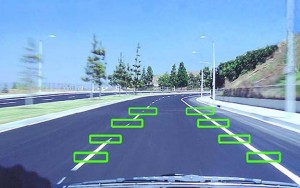
Lane departure warning systems, once limited to luxury cars, will soon be a mainstream, $14 bil business, a new study suggests.
Maybe you’re looking for another radio station, or yelling at the kids in the back of your minivan, but suddenly, a loud beep-beep grabs your attention. You’ve inadvertently begun to drift across the double yellow line – and your lane departure warning system has sounded a warning.
The technology, which uses an intelligent vision system, has become increasingly common on high-line products from makers like Infiniti, BMW and Mercedes-Benz. Some luxury makers, such as Lexus, even allow the system to automatically a car back into its lane.
Now, lane departure warning systems are following the path of other high-tech safety hardware, migrating downward into more mainstream offerings, notes a new study by ABI Research, which predicts that by 2016, lane departure warning technology could be a $14.3 billion line of business.
For 2011, the technology will migrate from models like the big Mercedes S-Class into the maker’s less-expensive C-Class. But Ford will begin offering a lane departure warning system in the decidedly mainstream 2011 Focus.
That fits the maker’s policy, which global marketing chief Jim Farley calls “democratizing technology.”
Similarly, Ford introduced cross-traffic alert — which uses radar sensors in the back fenders to watch for oncoming traffic while backing out of a parking spot — on the latest Taurus sedan just a year after the technology debuted on the BMW 7-Series.
And Ford isn’t alone. Pressed to hang onto customers who might move up-market, mainstream brands are rapidly adopting technologies first launched in the luxury segment, especially in the safety and infotainment arenas.
“That keeps us on our toes coming up with new technology,” says Ernst Lieb, CEO of Mercedes-Benz USA.
What’s significant is the pace at which technology is now moving down-market. When anti-lock brake systems, or ABS, first launched in the late 1980s, it took a decade before it became relatively commonplace across the industry. But today, luxury makers may have only a year or two lead, acknowledged Mercedes’ Lieb.
There are a variety of reasons why the pace is picking up, according to industry experts. For one thing, there are new government mandates for safety, mileage and emissions. The National Highway Traffic Safety Administration will soon require the across-the-board use of stability control, an advanced form of ABS that can prevent cars from losing control while driving too quickly or on slippery pavement.
Worried about the number of deaths and injuries caused when motorists might, for example, miss a child playing behind a big SUV, regulators are also pressing for the widespread use of backup cameras.
Motorists are, in some cases, demanding technologies even before regulators step in. That’s more the case now than ever before when it comes to safety. But customers are also pressing for the widespread adaption of advanced infotainment systems .
A decade ago, BMW was one of the worst to create an integrated, computer-like in-car technology, dubbed iDrive. Ford is now using its Sync system — which uses computer-like controls, as well as advanced voice commands – to lure in tech-savvy young motorists. And a half-dozen other minstream makers, including Hyundai and Toyota, previewed their own high-tech infotainment systems at the recent Consumer Electronics Show.
As with home electronics, the price of digital onboard technology is falling rapidly, and in many cases, upgrading to a more advanced feature may involve little more than adding lines of code. Take Lane Departure Warning.
“Lane departure warning has not enjoyed great commercial success as a standalone application,” says ABI Research principal analyst David Alexander, “but now we are seeing a number of significant new features that can share the core components and add considerable value for the driver. It is this expanded functionality that will drive the market growth.”
The same cameras that watch to see if a vehicle has drifted across the line can be used to check if there’s traffic in that vehicle’s blind spot, for example. Add a second, forward looking camera and code for language recognition and the technology can read road signs, advising the driver to slow down, for example.
In many cases, it becomes more efficient for makers to offer new technologies across the board, rather than limiting them to specific vehicles, suggests ABI.
While costs of individual devices continue coming down, the overall tech content in an automobile is going up. By various estimates, the typical car now has more than $2,000 in electronics onboard, and on high-line luxury models, that can push to $10,000, even $20,000 or more.
